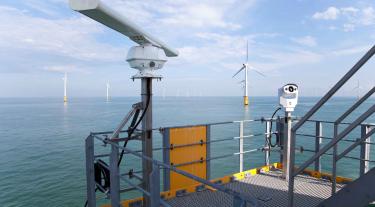Background
Compliance with regulatory requirements demands clear evidence on how birds behave within and around offshore wind farms to ensure the risk to species is minimal. The Offshore Renewables Joint Industry Programme (ORJIP) Bird Collision Avoidance (BCA) Study was set up to support developers, government and environmental stakeholders to address the uncertainty around how bird behave around an offshore wind farm.
Current consenting processes quantify bird collision risk using collision risk models. In order to quantify bird collision risk, these models use the specification of wind turbines and current knowledge about behaviour, distribution and flight speeds as their input parameters to quantify the risk to birds. The collision risk modelling is then corrected, to factor in the theoretical behavioural responses of birds to the presence of turbines - i.e. avoidance.
However, there is uncertainty over the avoidance rates of most groups of birds due to the relatively few empirical evidence based monitoring studies looking at bird behaviour undertaken at operational offshore wind farms.
Due to this lack of empirical evidence from offshore wind farms, it became clear to government and industry that innovative, large-scale research was needed to improve our understanding. Specifically, the need to develop a deeper understanding of how seabirds behave within and around an operational wind farm and gather empirical evidence to improve collision risk models and understand the true risk of collision for key seabird species.
To address the demand for robust evidence on the avoidance behaviour of seabirds around offshore wind farms the ORJIP BCA Study coordinated by Carbon Trust was undertaken at the Thanet Offshore Wind Farm, UK (Vattenfall) between July 2014 and June 2016. The multimillion pound collaborative study was commissioned by 11 leading offshore wind developers, The Crown Estate, The Crown Estate Scotland and Marine Scotland, was supported with funding from the UK Government. The project was developed and run with the support and advice from the UK and Northern Europe’s leading ornithologists and environmental advisors such as Natural England and RSPB.
Running the project through ORJIP meant shared project cost, resulting in a much more ambitious scope, ensuring the impact of the study could be more significant than if carried out by one organisation. Additionally, it was evident that the findings from this research would be valuable to a number of stakeholders with a strategic interest in the consenting process in the UK and international offshore wind market.
Main project aims
- Development of a bird monitoring system, that allows detecting and tracking bird movements at the species level in and around an operational offshore wind farm.
- Monitoring of seabird behaviour by deploying a multiple sensor monitoring system at macro (response to wind farm perimeter), meso (response to individual turbines) and micro (response to rotor and individual turbine blades) scale.
- Development of an appropriate methodology for quantifying empirical avoidance rates (EARs).
The methodology for the data collection was based on the use of radars, as bird surveys only represent snapshots and telemetry (remote data collection) only captures information on a few individuals. Radars have become an indispensable tool for obtaining long-term monitoring data on seabird behaviour at wind farms.
An automated multi-sensor monitoring system with integrated radar and digital camera was developed and installed at two turbine platforms. The system made it possible to monitor continuously (24/7) four turbines from one unit and generate documentation for flight paths both as visual and thermal videos coupled with radar data. In addition, trained bird observer teams were deployed at times by day at two different turbines located at the periphery of the wind farm to track seabird movements aided by radars and laser rangefinders.
All project partners agreed that 5 key seabird species of greatest concern for the offshore wind farm projects being developed at the time should be the focus of the project.
The priority seabird species monitored were:
- Northern gannet
- Herring gull
- Lesser black-backed gull
- Great black-backed gull
- Black-legged kittiwake
Outcome
The conclusions from this research on collision risk will allow better informed wind farm design and consent decisions just as the next generation of more powerful offshore turbines are being tested and manufactured. As a result the research will support UK Government plans to rapidly and sustainably grow the offshore wind sector by 2030.
The vast amount of data from the project is being hosted on The Crown Estate’s Marine Data Exchange and is publically available.
Related links


